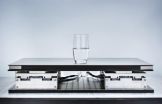(Press-News.org) Whether you're looking at hairy spider legs, the alien-like faces of ants, or the spiky-looking surfaces of pollen – a scanning electron microscope delivers high-resolution images that are rich in detail. But you can't get perfect images unless you protect the microscope from vibration. If someone walking across the room or an elevator going up and down between nearby floors makes the table shake, you're unlikely to get good results. The simplest way to quell vibrations is to put the microscope on a granite base – a stone so heavy that it dampens vibrations occurring at high frequencies from two to three Hertz. Placing a microscope on granite will make it far less susceptible to interference, but not necessarily those vibrations occurring at lower frequencies. When scientists wish to protect sensitive measuring devices from interference, they turn to active damping or, more specifically, an isolation platform. Each of the platform's four integrated swivel-mount modules contains a sensor that measures any vibrations in all three directions and an actuator that counterbalances them in three dimensions.
More cost-effective and compact without compromising performance
Researchers at the Fraunhofer Institute for Structural Durability and System Reliability LBF in Darmstadt have now come up with the first vibration control table of its kind to incorporate function-integrated components. "So instead of using non-adjoining sensors and actuators that are built into the table legs, we have integrated these functional elements directly into the platform's mounting modules," says engineer Torsten Bartel from Fraunhofer LBF. This has the advantage of making the vibration control table considerably more streamlined and cheaper to produce. And practical tests have already shown that the system works. The table dampens interfering vibrations just as well as its traditional counterparts. From April 7-11, the scientists will present their prototype at the Hannover Messe (Hall 02, Booth D13).
So how exactly does this table differ from its predecessors? "Conventional vibration control tables have mounts that are fitted with readymade actuators and sensors that work independently of the table itself. What we have done is to combine these functional elements beforehand within the mounts themselves. We don't use complete actuators – we use a number of interacting components that carry out the same function," explains Bartel. "So instead of having a system of individual elements producing a team effort, as was usual up to now, we have one composite unit." This includes connecting the actuators to the metal springs. Neither the actuator nor the springs could work on their own – they can only work together to protect the table.
"We can tailor our system to a variety of applications," says Bartel. This includes adaptations according to the size and weight of the equipment used – the table takes a different design if it is for, say, an electron microscope, than it would if it were meant for a smaller and lighter device. Reconfiguring the tables' geometry is the top priority here and simply making a smaller table is not enough. Changes in geometry affect the rigidity of the various elements. Similarly, the actuators and sensors take on a different design depending on the nature of the device: the larger the mass, the harder the actuators have to work in order to counteract vibrations.
INFORMATION: END
Getting rid of bad vibrations
2014-03-18
ELSE PRESS RELEASES FROM THIS DATE:
Who's afraid of math? Study finds some genetic factors
2014-03-18
COLUMBUS, Ohio – A new study of math anxiety shows how some people may be at greater risk to fear math not only because of negative experiences, but also because of genetic risks related to both general anxiety and math skills.
The study, which examined how fraternal and identical twins differ on measures of math anxiety, provides a revised view on why some children – and adults – may develop a fear of math that makes it more difficult for them to solve math problems and succeed in school.
"We found that math anxiety taps into genetic predispositions in two ways: people's ...
Suppressing unwanted memories reduces their unconscious influence on behavior
2014-03-18
Researchers part-funded by the Medical Research Council (MRC) have shown that, contrary to what was previously assumed, suppressing unwanted memories reduces their unconscious influences on subsequent behaviour, and have shed light on how this process happens in the brain.
The study, published online in PNAS, challenges the idea that suppressed memories remain fully preserved in the brain's unconscious, allowing them to be inadvertently expressed in someone's behaviour. The results of the study suggest instead that the act of suppressing intrusive memories helps to disrupt ...
Lessons from a meadow
2014-03-18
For almost 40 years, field scientists strapped on cross-country skis, shouldered backpacks with supplies and set out over three miles of snow and rocks to a field station by a meadow high in the Rocky Mountains as soon as the snow began melting. Every other day, they counted each flower they found, identified the plant it belonged to and kept meticulous records of their observations.
Their observations provide the longest-running scientific study of its kind and tell a story of biological change that teaches scientists new lessons about phenology – the timing of biological ...
Supplements not associated with reduced risk of cardiovascular disease in elderly
2014-03-18
Bottom Line: Daily dietary supplements of omega-3 polyunsaturated fatty acids (also found in fish) or lutein and zeaxanthin (nutrients found in green leafy vegetables) were not associated with reduced risk for cardiovascular disease (CVD) in elderly patients with the eye disease age-related macular degeneration.
Author: The writing group for the Age-Related Eye Disease Study 2 (AREDS2) clinical trial.
Background: Diet studies have suggested that increased intake of fish, a source of omega (ω)-3 fatty acids, can reduce rates of cardiac death, death from all other ...
Study finds high utilization of neuroimaging for headaches despite guidelines
2014-03-18
Bottom Line: Neuroimaging for headaches is frequently ordered by physicians during outpatient visits, despite guidelines that recommend against such routine procedures.
Author: Brian C. Callaghan, M.D., M.S., of the University of Michigan Health System, Ann Arbor, and colleagues.
Background: Most headaches are due to benign causes, and multiple guidelines have recommended against routine neuroimaging for headaches.
How the Study Was Conducted: The authors analyzed National Ambulatory Medical Care Survey data for all headache visits for patients 18 years or older ...
The frozen truth about glaciers, climate change and our future
2014-03-18
Lewis Owen has been scraping out icy fragments of history's truth from one of the most glaciated regions on Earth for the past 25 years.
His frequent excursions to Tibet and the Himalayas have led the University of Cincinnati professor of geology to some cold, hard facts.
Owen knows climate change is immortal – fluctuating across millennia, patiently building toward moments when circumstances are ripe for apocalypse. It was true thousands of years ago, when rapid climate change had profound effects on landscapes and the creatures that lived on them. That scenario could ...
Rice study: Simple changes to homework improved student learning
2014-03-18
A new study offers evidence that simple and inexpensive changes to existing courses can help students learn more effectively.
The study from Rice University and Duke University found that making a few changes to homework assignments in an upper-level undergraduate engineering course at Rice led to improved scores on exams. The study appears this week in the journal Educational Psychology Review.
The findings by a team from Rice's Center for Digital Learning and Scholarship and Duke's Department of Psychology and Neuroscience demonstrate how technology and cognitive ...
Researchers devise new, stretchable antenna for wearable health monitoring
2014-03-18
Researchers from North Carolina State University have developed a new, stretchable antenna that can be incorporated into wearable technologies, such as health monitoring devices.
"Many researchers – including our lab – have developed prototype sensors for wearable health systems, but there was a clear need to develop antennas that can be easily incorporated into those systems to transmit data from the sensors, so that patients can be monitored or diagnosed," says Dr. Yong Zhu, an associate professor of mechanical and aerospace engineering at NC State and senior author ...
A 'back to the future' approach to taking action on climate change
2014-03-18
How can communities dodge future disasters from Mother Nature before she has dealt the blow? Researchers are taking a unique approach to the issue and gaining input and support from community stakeholders. Daniel Murphy, a University of Cincinnati assistant professor of anthropology, will present findings on March 20, at the 74th annual meeting of the Society for Applied Anthropology (SFAA) in Albuquerque, N.M.
The presentation reveals an innovative, interdisciplinary research technique for approaching climate change vulnerability that's called Multi-scale, Interactive ...
Study finds risk of death among ICU patients with severe sepsis has decreased
2014-03-18
In critically ill patients in Australia and New Zealand with severe sepsis or septic shock, there was a decrease in the risk of death from 2000 to 2012, findings that were accompanied by changes in the patterns of discharge of intensive care unit (ICU) patients to home, rehabilitation, and other hospitals, according to a study appearing in JAMA. The study is being released early to coincide with its presentation at the International Symposium on Intensive Care and Emergency Medicine.
Severe sepsis and septic shock are the biggest cause of death in critically ill patients. ...




